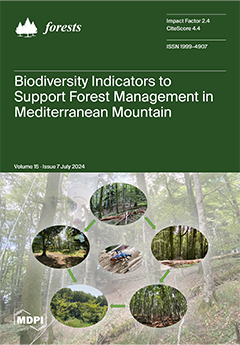Forestation is a common measure to control erosion-induced soil and carbon (C) loss, but the effect can vary substantially between different types of forest. Here, we measured event-based runoff, soil, dissolved organic carbon (DOC), particulate organic carbon (POC) and total C loss with
[...] Read more.
Forestation is a common measure to control erosion-induced soil and carbon (C) loss, but the effect can vary substantially between different types of forest. Here, we measured event-based runoff, soil, dissolved organic carbon (DOC), particulate organic carbon (POC) and total C loss with runoff plots (20 m × 5 m) in a broad-leaved and a coniferous forest in subtropical China and explored their relationships with rainfall amount, average intensity, maximum 5-min intensity and rainfall erosivity. The broad-leaved forest had a denser canopy but sparse understory vegetation while the coniferous forest had a relatively open canopy but dense understory vegetation. The results showed that runoff, soil, DOC, POC and total C losses were all significantly higher in the broad-leaved forest than the coniferous forest despite the potentially higher canopy interception associated with the greater leaf area index of the broad-leaved forest. The mean runoff in the broad-leaved forest was 3.03 ± 0.20 m
3 ha
−1 event
−1 (mean ± standard error) and 12.49 ± 0.18 m
3 ha
−1 event
−1 in the coniferous forest. The mean soil, DOC, POC and total C loss (kg ha
−1 event
−1) was 1.12 ± 0.16, 0.045 ± 0.003, 0.118 ± 0.016 and 0.163 ± 0.017, respectively, in the broad-leaved forest and 0.66 ± 0.09, 0.020 ± 0.002, 0.060 ± 0.009 and 0.081 ± 0.010, respectively, in the coniferous forest. Runoff and DOC losses were driven by rainfall in two forests, but the key rainfall characteristic driving soil, POC and total C losses was different in the broad-leaved forest from that in the coniferous forest due to their different understory patterns. Soil, POC and total C losses were mostly driven by rainfall amount in the broad-leaved forest but by EI
30 in the conifer forest. Our findings highlight that the response of erosion-induced carbon loss to rainfall characteristics differs between different forest types of the same age but contrasting overstory and understory vegetation covers. Moreover, our study underscores the overlooked significance of understory vegetation in regulating these effects. Thus, we call for the inclusion of understory vegetation in the modeling of soil and carbon erosion in forest ecosystems.
Full article





